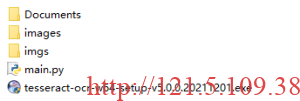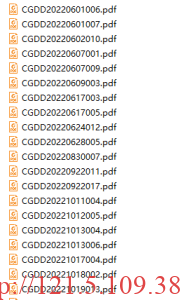提出问题
工作中有时要批量对pdf或者word文档进行批量规范命名,遇到这种事情往往人工成本会很大。因此,利用ocr工具自己写了一个小工具,可用于根据pdf中指定位置编号对文件进行批量重命名。
解决方法
算法的主要思想是:(1)将pdf转换成图片保存;(2)图片矫正(有些图片拍摄时倾斜);(3)根据图片中标号的位置进行ocr文字识别;(4)文件重命名。算法的识别准确率较高,但仍存在少量不准确,需人工调节。
import pytesseract
import numpy as np
import math
from scipy import ndimage
def pyMuPDF_fitz(pdfPath, imagePath, name):
startTime_pdf2img = datetime.datetime.now()#开始时间
print("imagePath="+imagePath)
pdfDoc = fitz.open(pdfPath)
page = pdfDoc[0]
rotate = int(0)
# 每个尺寸的缩放系数为1.3,这将为我们生成分辨率提高2.6的图像。
# 此处若是不做设置,默认图片大小为:792X612, dpi=96
zoom_x = 5 #(1.33333333-->1056x816) (2-->1584x1224)
zoom_y = 5
mat = fitz.Matrix(zoom_x, zoom_y).preRotate(rotate)
pix = page.getPixmap(matrix=mat, alpha=False)
if not os.path.exists(imagePath):#判断存放图片的文件夹是否存在
os.makedirs(imagePath) # 若图片文件夹不存在就创建
pix.writePNG(imagePath+'/'+ name + '.png')#将图片写入指定的文件夹内
#endTime_pdf2img = datetime.datetime.now()#结束时间
#print('pdf2img时间=',(endTime_pdf2img - startTime_pdf2img).seconds)
def rotate(img):
gray = cv2.cvtColor(img,cv2.COLOR_BGR2GRAY)
#print (gray.shape)
# 边缘检测
edges = cv2.Canny(gray,50,150,apertureSize = 3)
#霍夫变换,摘自https://blog.csdn.net/feilong_csdn/article/details/81586322
lines = cv2.HoughLines(edges,1,np.pi/180,0)
for rho,theta in lines[0]:
a = np.cos(theta)
b = np.sin(theta)
x0 = a*rho
y0 = b*rho
x1 = int(x0 + 1000*(-b))
y1 = int(y0 + 1000*(a))
x2 = int(x0 - 1000*(-b))
y2 = int(y0 - 1000*(a))
if x1 == x2 or y1 == y2:
pass
t = float(y2-y1)/((x2-x1)+1)
# 得到角度后
rotate_angle = math.degrees(math.atan(t))
if rotate_angle > 60:
rotate_angle = -90 + rotate_angle
elif rotate_angle < -60:
rotate_angle = 90 + rotate_angle
# 图像根据角度进行校正
rotate_img = ndimage.rotate(img, rotate_angle)
return rotate_img
if __name__ == "__main__":
imagePath = './images'
pdf_dir = './Documents'
for file in glob.glob('./Documents/*.pdf'):
print ('正在处理:', file)
name = os.path.split(file)[1][:-4]
#print (name)
pyMuPDF_fitz(file, imagePath, name)
img = cv2.imread(imagePath + '/' + name + '.png')
img = rotate(img)
cv2.imwrite('./imgs' + '/' + name + '.png', img)
left_thred = 230
gray_img = cv2.cvtColor(img, cv2.COLOR_RGB2GRAY)
ret, thresh1 = cv2.threshold(gray_img, left_thred, 255, cv2.THRESH_BINARY)
blur = cv2.blur(thresh1,(3,3))
y = 735
x = 575
h = 80
w = 462
crop_img = img[y:y+h, x:x+w].copy()
text = pytesseract.image_to_string(crop_img)
print (text)
if not os.path.exists(pdf_dir + '/' + text.replace("\n", "") + '.pdf'):
os.rename(pdf_dir + '/' + name + '.pdf', pdf_dir + '/' + text.replace("\n", "") + '.pdf')结果
图1 整个代码文件存放;图2 输出的文件重命名结果

图1

图2
注:其中tesseract-ocr需下载安装,并在anaconda配置该库路径。
- 配置tesseract运行文件
一般地,在C:\ProgramData\Anaconda3\Lib\site-packages\pytesseract目录下pytesseract.py文件找到tesseract_cmd = 'tesseract',改成tesseract_cmd = 'C:/Program Files/Tesseract-OCR/tesseract.exe'即可,具体路径按自己安装的tesseract路径配置。

文章评论